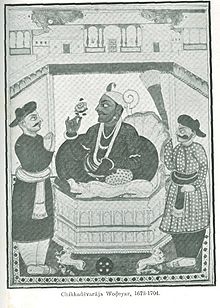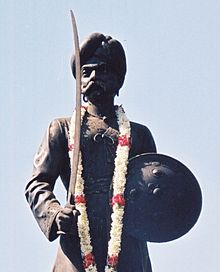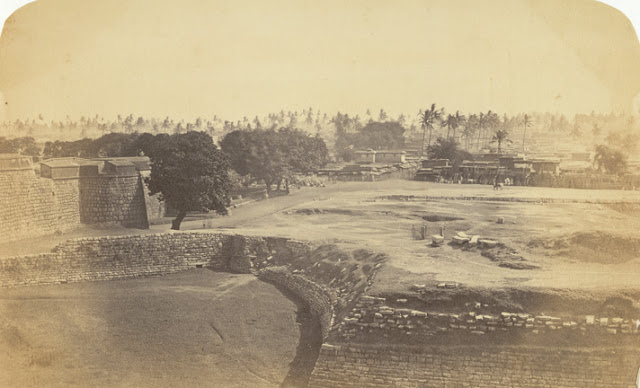.
In the Year 1690
As he tucked his dhoti into a neat knot, Gati tried to listen to his parent’s excited whispers. Though he was just a boy of eleven, he could sense it. There was something different about the day. Through the thatch windows of his agrahara, he had spotted an uncommon number of people on the street. The winds seemed to susurrate strange secrets, determined to rouse a usually imperturbable village into excitable gossip. “Amma, I am going to the aralikatte!” he screamed and ran out the door.
His had already begun a game of chowkabhara. He ran to the stone setting surrounding the tree, where a group of men had gathered in a deep dialogue.
“Finally! After so many years, the King has finally got his heart’s desire!” Veerappa was exclaiming. “And he got it at such a cheap rate too. Three lakh rupees!” All of them were fervently nodding their heads, pretending that the amount was a pittance.

Veerappa looked at Gati then, standing in the sides, staring at the men with undisguised curiosity. He beckoned, “Gati, do know what is happening?” Gati shook his head. Veerappa continued, “The Mughals have finally agreed to sell Bengaluru Pete to our king. Chikka Deva Raja had wanted this since his pattabhisheka. ” Veerappa, realizing that he had the interest of his young audience piqued, asked, “Have your parents told you about Bengaluru? Do you know how a jungle of wild trees became a big Pete?” Seeing Gati’s vacant expression, Veerappa was delighted. “Then listen! I will tell you a story –
One day, when he was on a hunting expedition, King Veera Ballala got lost in the jungle. The forest was thick, primal & barbarous. It was after roaming around for quite some time that the exhausted King came across a lone hut, occupied by an old lady. The lady offered the hungry king the only thing in her possession – boiled beans. The king referred to the jungle from then on as Bendakaluru.
Approximately 175 years ago, when the year was 1513, a man called Kempe Gowda became the chieftain of the clan of Yelahanka Nada Prabhus. They were the pollegars for the Vijayanagara kings and lorded over the jahgir from Yelahanka. Kempe Gowda was a fantastical dreamer. Once, when he was on a hunting expedition, he saw a very strange sight. A rabbit chasing his hunter dogs! This convinced him that the land was uncommon and great. He started calling it gandubhumi. Do you know what it means Gati? Gandu, or man, is the embodiment of all the brave & courageous characteristics of mankind. Where rabbits could chase dogs, bravery was inseminated in the very cells of beings of the land, he said.

Kempe Gowda started conquering land and expanding his principalities. After nearly 24 years of being the Pollegar, he decided he would build a township. Finally, in 1537, after clearing the jungle and determining the most auspicious moment, he began the gudlipooje. My great grandfather used to tell us about the pooje when we were little boys, of the eight bullocks which started ploughing the land for streets. They were huge, white beasts; tied as pairs to decorated ploughs. Upon receiving the royal command and to the beats of the regal valaga, each pair set off in opposite directions. The paths forged by these bullocks became the four great streets. That’s how the city came to being –with Halsoor Gate in the west to Sondekoppa Gate in the east and Yelahanka Gate in the north to Anekal Gate in the south. Have you been to the Dodpet Chowki, Gati? Remember this the next time you go there, it is the place from which the bullocks were shepherded to create the boundary. Kempe Gowda rechristened it to Bengaluru, after the Bangaluru hamlet existing near the new town. Craftsmen came by hordes and beautified the city. You have seen the various pete’s with your own eyes. It was he who ensured that they were organised, each pete traded only a certain kind of goods. There is no place in the immediate surroundings which sells better clothes than Chikpete! He became so popular that the Vijayanagara Kings gifted entire villages to Kempe Gowda.
Do you know what happens when a man becomes successful? He is the cynosure of all envy. Kempe Gowda, for all his greatness, could not escape this irrefutable law. He dug his own pit when he started a new mint of his own. He made Vira Bhadra Varahas the new currency for his jahgir. This enraged the Vijayanagara Kings, who were the suzerains of Kempe Gowda, and whose currency he was obligated to use. Jagadeva Raya was the Pollegar of Channapatna at that time. The jealous Jagadeva immediately instigated the Kings to imprison Gowdru in the Anegundi prison.
Kempe Gowda was a captive for five years. Prison was a place which fueled his ambitions. He witnessed the beautiful temples & palaces of Vijayanagara. It was a dream which he had dreamt for his city. He became a shiv-bhakt in this time. He took an oath to build a temple to his beloved deity if he came to be released from jail. Probably his gods were kind, or it was the fruits of the good deeds done by his ancestors. Vijayanagara was in great turmoil and facing invasions from the newly united kingdoms of Nizam Shah of Ahmednagar, Bijapur& Golkonda. Kempe Gowda offered to pay a huge sum of money for his release and was set free.
The people of Bengaluru were joyous to see the return of their leader. Kempe Gowda made his wish of constructing a temple dedicated to Shiva known to his son. Finally, 70 years ago, and nearly 50 years after his death, the Gavi Gangadheshwara Devasthana was completed by Kempe Gowda’s son, Immadi Kempegaunayya. You have been there Gati, now you know why it was built.”
Veerappa looked expectantly at the boy, replete with a lordly nod. It was rare for the old man to encounter willing and oblivious audience. Immensely enjoying the look of awe dedicated on Gati’s face, he stood up to spit the nutmeg he was chewing, tucking his dhoti about his knees. He knew that the boy would find him again, for this story was unfinished.
In the words of Cicero, “To know nothing of what happened before you were born, is to forever remain a child.” It is through history that we learn the importance of today’s deeds. It gives us an indubitable perspective of our importance, of where we stand in the great ebb of life. Very few of us give pause and reflect on our origins. Every inch of land, like people, have unsung stories which should to be heard. And a school curriculum never does justice to the tiny streets in great cities, the places which birthed the legends.

As many Bangaloreans may recognize, some of the old sects of the city are still in existence today, and some even go by the same name. Chikpete, Dodpete and the areas around Avenue Road is the legacy left behind from our ancestors. Gavigangadheshwara Temple continues to be one of our biggest attractions, the sliver of sunlight falling on the idol on Shankranthi continues to fascinate many. It is interesting to note that the provinces of Begur, Jigani, Varthur, Kengeri, Banavara and Kumbalgode were initially gifted to Kempegowda for his visionary work by the Vijayanagar Kings.
And the story of how this city passed from the hands of Kempegowda to Sultans to Wodeyars to the British and become a posh Cantonment is an arresting tale – stay tuned!
PICTURE COURTESY WIKIPEDIA





Very well written. I am eagerly waiting to read 2nd part of the article.